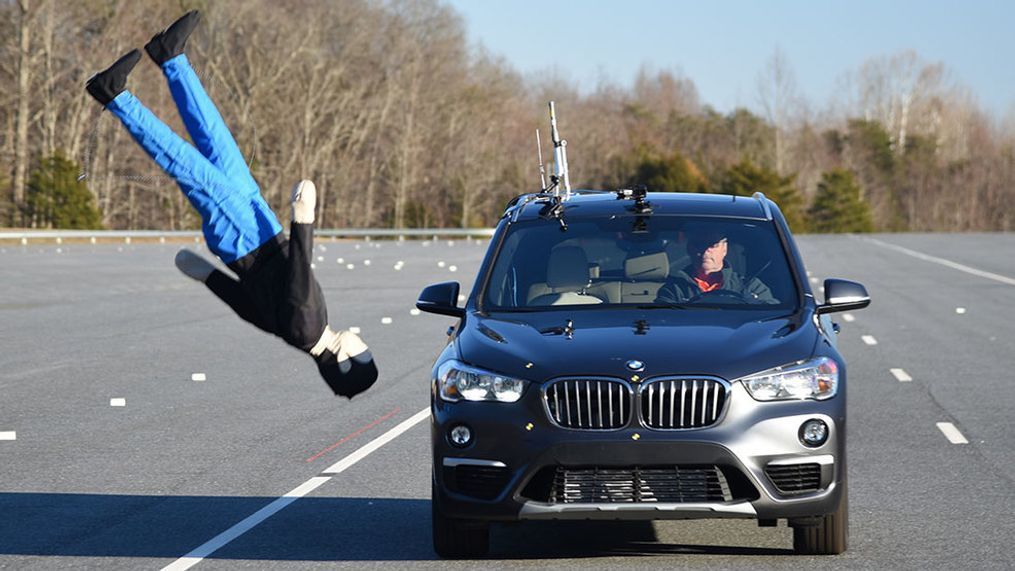IIHS toughens criteria for Top Safety Pick awards

Front crash prevention that earns at least an advanced rating in both the vehicle-to-vehicle and vehicle-to-pedestrian evaluations will have to be available. Previously, only the vehicle-to-vehicle rating was required. (Image courtesy of the Insurance Institute for Highway Safety)
The Insurance Institute for Highway Safety will toughen safety standards for its coveted Top Safety Pick awards, the insurance-funded group announced Wednesday. But those standards include pricier equipment, such as LED headlights, that cost more for new car shoppers.
“We’re interested in promoting safety,” Joseph Young, media relations with the IIHS, said in an interview. “And as we see the technologies become more mainstream, we’ll see these prices go down.”
The IIHS is putting the safety spotlight on headlights for 2020 vehicles. To qualify for Top Safety Pick+ and Top Safety Pick awards, vehicles must have headlights that receive “Good” or “Acceptable” ratings as standard equipment, whereas last year it could be optional equipment.
The IIHS launched headlight ratings in 2016 because a disproportionate number of the estimated 40,000 annual traffic fatalities occur at night, Young said. There haven’t been any significant changes to the federal headlight requirements since 1997, and even that provision is based on safety standards developed in the 1960s.
“We quickly learned that headlights were not lighting up the road very well, so vehicles were overdriving their headlights,” Young explained. “When something comes into view, you might not be able to stop in time.”
Typically, more expensive LED projector and reflector headlights perform much better than halogen lights. But those headlights historically have been offered as optional equipment on higher trim levels. The change to the awards criteria is meant to simplify it for consumers and prod automakers to offer safer headlights as standard equipment.
“We want to weed out the good from the bad,” Young said. “We hope it encourages the crummier headlights to drop out of production.”
The IIHS can set the safety bar for automakers, but doesn’t have much influence over cost. In a 2018 report, the IIHS found a wild variance in average headlight assembly cost between automakers, ranging from $526 in the Subaru Legacy to $3,242 in the BMW 5-Series.
The rise of life-saving crash mitigation technology, such as LED headlights and automatic emergency braking that will be standard on nearly all 2022 vehicles, comes at a cost that is passed on to consumers. This is one of several reasons the average transaction price of new cars is at a record, exceeding $38,000.
The insurance industry benefits from such safety features because fewer crashes means fewer claims to fulfill. But the IIHS maintains that it serves safety first.
“Our mission is to prevent crashes, especially those with injuries,” Young said. “Yes, it’s good for insurance companies, but it’s good for everyone.”
In addition to being more expensive, new cars are also safer.
“The proportion of vehicle occupants who were fatally injured increases with the age of the vehicle,” the NHTSA found in 2018.
Because the crash testing and safety standards of the IIHS are far more rigorous than the NHTSA, which is woefully behind the times, automakers pursue the standards set by the IIHS, going so far as to nominate certain cars that should get tested in hopes of a TSP or TSP+ award. With the resources to test only 50 to 70 models annually, the IIHS is conscious of not raising the bar too high from year to year.
“We work closely with automakers...and want them competing for these awards,” Young said. “If we make them too difficult, everyone can throw up their hands and say forget it.”
The IIHS does change its crash standards periodically, which makes it difficult to compare Top Safety Pick awards from year to year.
Also for 2020, pedestrian crash prevention ratings will be factored into TSP and TSP+ awards. The inclusion of pedestrian crash prevention for the first year is meant to address the growing number of pedestrian fatalities in the U.S. Pedestrian fatalities hit a 28-year high in 2018, with 6,227 pedestrians killed, accounting for more than 15% of traffic fatalities, according to the Governors Highway Safety Association.
